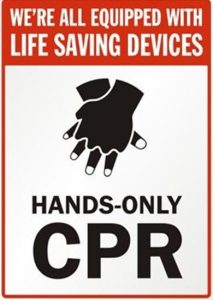You’re walking your dog in the neighborhood park and you see a man riding a bike up ahead suddenly collapse. Would you know what to do?
The American Red Cross is now teaching Hands-Only CPR. Studies have shown performing Hands-Only CPR on someone who has suddenly collapsed in front of you can make a lifesaving difference and you don’t need to be certified to do it.
How to Perform Hands-Only CPR


Hands-Only CPR is as simple as these 3 steps:
1. Check and Call.
Check the scene before you check the person. Is your safety at risk? You won’t be of any help if you get injured.
Check the person by tapping on the shoulder as you shout “Are you okay?”, then quickly check for breathing. Watch the chest to see if it rises and falls.
If there’s no response or breathing, call 9-1-1 or send someone to do it for you. If you’re in a group of people, actually assign the task of calling 9-1-1. Just shouting “Someone call 9-1-1!” is risky because it’s easy for people to assume someone else is making the call and as a result, no one calls.
Related: What You Really Need in Your SHTF First Aid Kit
2. Give Chest Compressions.
If the person’s not breathing, begin chest compressions.
How to Give Chest Compressions:
- Place one hand on the center of the chest.
- Place your other hand on top of the first hand, interlocking your fingers.
- Keep your arms straight, position your shoulders directly over your hands.
- Push hard and fast, at least 100 times per minute.
How fast is 100 times per minute?
Oddly enough, if you push to the beat of the Bee Gees hit, “Stayin’ Alive” or Queen’s “Another One Bites the Dust” you’ll give chest compressions at the right tempo.
3. Do Not Stop!


Continue pushing hard and fast and don’t stop unless one of these things happen:
- The person starts breathing on his own.
- Trained help arrives and takes over.
- You’re exhausted and you can’t continue.
- Your safety is at risk.
I still intend to get certified in full CPR—rescue breathing and all—in the near future and I highly recommend you do, too. Hands-Only CPR is ideal for cardiac emergencies but it’s better to know full CPR if you’re around infants, children or spend a lot of time at the neighborhood pool and it’s the best option for choking victims or anyone found already unconscious.





















